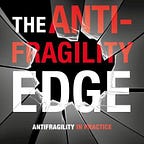Expect the Unexpected: From “Embracing Change” to “Embracing Disruption”
The PwC/PricewaterhouseCoopers International 16th Annual Global CEO Survey “Dealing with Disruption: Adapting to Survive and Thrive” emphasizes “the shift”:
During the past decade, we’ve seen economic volatility and disruption escalate to arguably unprecedented levels. In a globalised world — one where countries, economies and companies are more interconnected and interdependent than ever before — risks that once seemed improbable and even remote have become the norm. For business leaders across the world, ‘expect the unexpected’ has become the mantra.
The only way forward is to build organisations that can survive and thrive amidst disorder: organisations that are agile and adaptable, able to cope with disruption and emerge stronger than before.
Historically, we have predominately focused on “change”, but now, reality demands that we focus on “disruption”. The world has become far too turbulent to merely “manage change” or “embrace change” but now requires us to “work with disruption” or “embrace disruption” (or even more so “embrace chaos”) — fundamentally, a shift from the “age of change” and Agility to the “age of disruption” and Antifragility, a term coined by Nassim Nicholas Taleb in his book Antifragile: Things That Gain from Disorder.
The “age of change” equates normalcy with equilibrium — balancing various forces towards stability, certainty, simplicity, and clarity — and embracing change, disturbances and deviations. The “age of disruption” equates normalcy with VUCA — volatility, uncertainty, complexity, and ambiguity — and embracing disruption, more VUCA.
For over a decade, the Agile community has focused on adopting, sustaining, and generally embracing foundational agility (using Scrum, XP, Lean, Kanban, and similar approaches) and scaling agility (using Disciplined Agile Delivery or DAD, Large Scale Scrum or LeSS, Scaled Agile Framework or SAFe, and similar approaches) while, perhaps unintentionally, disseminating fragility by predominately over focusing on “change” and not confronting “disruption” — the law of unintended consequences.
Now, many practitioners are embracing DevOps, Continuous Delivery, Microservices, and Chaos Engineering, among other approaches, to advance towards the “age of disruption”. But more broadly, how do we advance business and technology in partnership from “embracing change” to “embracing disruption”?
As agility focuses on change, antifragility focuses on disorder. Agility involves embracing change by confronting and responding to reality while adapting and surviving. Antifragility involves embracing disruption/randomness/chaos by embracing and gaining from reality while evolving and thriving.
Recognizing that reality is perpetually disruptive, each disruption presents an opportunity or threat based on our strengths and weaknesses. Based on our strengths, we may seize a disruption as an opportunity. Based on our weaknesses, we may address a disruption as a threat. Furthermore, we must work to further develop opportunities and strengths as well as transform weaknesses into strengths and threats into opportunities so as to adapt and survive as well as evolve and thrive. This is what the antifragility edge is all about.
Visit the Antifragility Edge for more about the emerging post-agile/post-agility paradigm and practice of antifragility. I also delivered the “The Antifragility Edge: Business and Technology” workshop (Sept-30, 2016, Milwaukee, WI, USA) at the Center for Technology Innovation.
